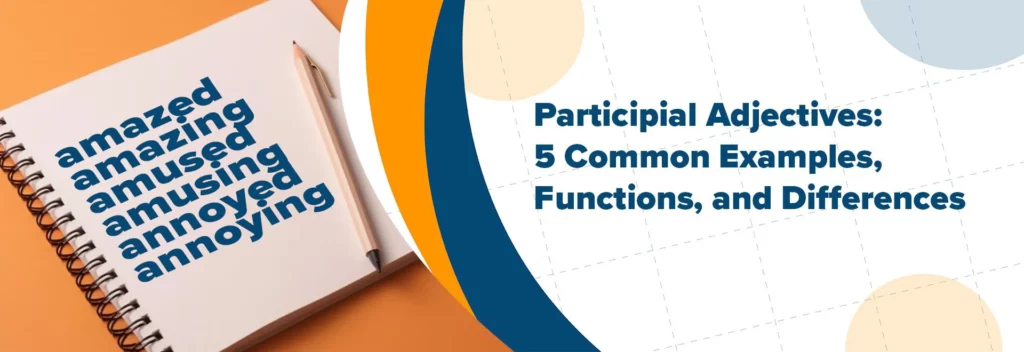
Participial Adjectives: 5 Common Examples, Functions, and Differences
“Participial adjectives? What is that?” This must be the question that came into your mind when the title appeared in front of you. You may not be familiar with participial adjectives and you wonder what these are. We will answer your questions in mind, so keep reading this article and we will learn some examples and their differences together.
Participial Adjectives
This is not commonly identified as a part of English language learning, but participial adjectives, also called participle adjectives, are adjectives that end with –ed, -d, or –ing. These adjectives are formed from the participle of a verb but are used as modifiers for nouns in sentences.
There are two types of participial adjectives.
■ Present Participle Adjectives – these adjectives are usually formed with the –ing. If you cannot recognize that the word used in a sentence is a present participle adjective, then you must be thinking that it is the present continuous form of the verb because of the –ing.
Example: I never expected the show to be disappointing.
■ Past Participle Adjectives – these are adjectives that are usually formed with –ed, or -d. You must think that the words ending in these suffixes are past forms of the verb if you cannot easily identify its usage in the sentence.
Example: The show disappointed me.
Some people are not familiar with how participial adjectives are formed and how they function in sentences. They are commonly used but it is hard to identify them if you do not analyze them carefully. Below are some examples of commonly used participial adjectives. Let’s talk about them and discuss their differences.
5 Commonly Used Participial Adjectives and Their Differences
- Excited and Exciting
These participial adjectives describe emotions and how something affects your emotions. Excited is used when you describe how you feel. Exciting, on the other hand, is used when you talk about something that makes you feel excited.
Examples:
I am so excited to see a new Disney film. – Here, you feel an urge and eagerness to see the new film from Disney.
Elemental, the new Disney film I just watched, is exciting. – Here, the participial adjective “exciting” refers to the movie Elemental. It describes the movie and not the emotion.
- Annoyed and Annoying
These adjectives also describe emotions and something that affects your emotions, although they connote a negative meaning.
Examples:
My younger brother was annoyed by my older sister. – The participial adjective “annoyed” here refers to the feeling felt by the younger brother. It must be because of something that makes him feel annoyed.
My older sister doesn’t like my younger brother because he is annoying. – In this sentence, the participial adjective “annoying” refers to the brother who causes the older sister to feel annoyed.
- Frightened and frightening
These participial adjectives are used to describe an extreme feeling when something happens or when someone sees something.
Examples:
I was frightened by the decorations in our office. – The participial adjective “frightened” here is an extreme emotion that the speaker in the sentence felt.
The decorations in our office are frightening. – Here, it’s the decorations that cause an extreme feeling.
- Bored and Boring
Bored and boring denote a slightly negative meaning because it makes someone feel weak when these words are uttered. These participial adjectives are used to describe how you feel about something, especially when that something is associated with entertainment.
Examples:
My younger sister felt bored at home so she went to see a movie at the theater. – “Bored” in this sense describes the feeling of being unhappy or having nothing to do. There’s a feeling of being weak as well.
The show was boring so my younger sister went home. – In this sense, the participial adjective “boring” refers to the show (as the subject in the sentence).
- Interested and Interesting
These two participial adjectives are more positively connoted as they refer to the urge to get or to have something.
Examples:
The students are interested in learning English interactively. – The participial adjective “interested” here shows the student’s eagerness and willingness to learn English.
Learning English interactively is an interesting way to improve your speaking skills. – “Interesting” here refers to the subject that makes someone feel interested or have the urge to succeed in something (e.g. improving speaking skills).
Generally, participial adjectives denote two simple meanings. Participial adjectives ending in –ed refer to a “feeling”, whilst those ending in –ing refer to “something that causes the feeling.” In short, participial adjectives are adjectives that describe someone’s feelings or emotions and the causes of these emotions.
Take Note:
Although participial adjectives usually end in –ed, -d, or –ing, not all of them can be paired to identify a feeling or what causes the feeling. Talented, for example, ends in –ed but it cannot be paired with talenting because there’s no such word as talenting. It is not necessary that participial adjectives (-ed, -d, and –ing forms) have to be paired.
See more examples below:
- I am pleased to announce the new manager.
- Have you ever tasted baked macaroni?
- The school she works in is student-centered.
Take note also that not all participial adjectives are formed from a verb, but they are also formed from a noun that does not have any corresponding verb. For example, the word talented is from the noun talent.

How to identify participial adjectives in sentences?
It is easy to spot an adjective in a sentence, but it is not too easy to spot participial adjectives. How would you know that the word ending in –ed or –ing in a sentence functions as an adjective or a verb? Look at the examples below.
Sentence 1: You disappointed our father for breaking his rules.
Sentence 2: Our father was disappointed for breaking his rules.
If you analyze the two sentences, the word disappointed in Sentence 1 functions as a verb because it follows the subject and there is no existing verb in the sentence. Sentence 2 functions as an adjective because it talks about the father’s feelings about breaking his rules.
Sentence 1: Mr. Warner was scolded for disappointing his client.
Sentence 2: Mr. Warner’s unprofessional act was disappointing.
The two sentences differ in function. Sentence 1 functions as a verb. It is the reason why Mr. Warner was scolded. On the other hand, Sentence 2 functions as an adjective as it refers to the unprofessional act by Mr. Warner.
Basically, you can easily identify the function of a word ending in –ed or –ing based on the parts of speech they precede or follow.
Participial adjectives are usually preceded by a be-verb (am, is, are) and other helping verbs such as feel, make, seem, keep, get, look, etc. As well as adverbs in sentences (e.g. very excited, extremely annoying). They also precede the noun or pronoun they modify like a disappointed look, a frustrating performance, etc.
Try to identify the function of the words ending in –ed and –ing in the following sentences.
- The chairman of the committee was tired because of an unexpected incident.
- I will keep annoying you for the rest of your life.
- Lauviere has been thankful for the fascinating performance of his group.
- All the students satisfied the audience with their awesome song.
- His fans liked him for being a talented
How many have you got right? You can check your answers HERE.



